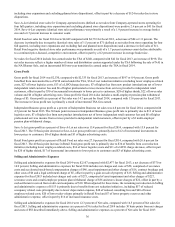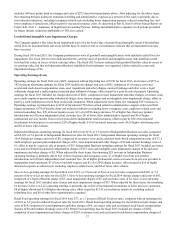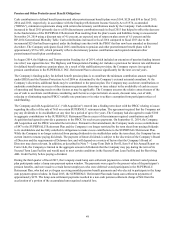Albertsons 2015 Annual Report Download - page 46
Download and view the complete annual report
Please find page 46 of the 2015 Albertsons annual report below. You can navigate through the pages in the report by either clicking on the pages listed below, or by using the keyword search tool below to find specific information within the annual report.44
Company’s Independent Business reporting unit exceeded its carrying value by approximately 80 percent. The fair value of
goodwill for the Company’s Save-A-Lot and Retail Food reporting unit was in excess of 100 percent of the carrying value. If
the Company’s stock price experiences a significant and sustained decline, or other events or changes in circumstances, such as
a material shortfall of operating results to plan, the Company would reassess the fair value of the Company’s reporting units to
their carrying value.
The Company completed step one of the annual goodwill impairment evaluation during the fourth quarter for fiscal 2015 and
2014 with each reporting unit’s fair value exceeding its carrying value. Accordingly, step two of the impairment analysis was
not required for fiscal 2015 and 2014.
Benefit Plans
The Company sponsors pension and other postretirement plans in various forms covering substantially all employees who meet
eligibility requirements. Pension benefits associated with these plans are generally based on each participant’s years of service,
compensation, and age at retirement or termination. The Company’s defined benefit pension plan, the SUPERVALU
Retirement Plan, and certain supplemental executive retirement plans were closed to new participants and service crediting
ended for all participants as of December 31, 2007.
While the Company believes the valuation methods used to determine the fair value of plan assets are appropriate and
consistent with other market participants, the use of different methodologies or assumptions to determine the fair value of
certain financial instruments could result in a different estimate of fair value at the reporting date.
The determination of the Company’s obligation and related expense for Company-sponsored pension and other postretirement
benefits is dependent, in part, on management’s selection of certain actuarial assumptions used in calculating these amounts.
These assumptions include, among other things, the discount rate, the expected long-term rate of return on plan assets and the
rates of increase in compensation and healthcare costs. Refer to Note 11—Benefit Plans in the Notes to Consolidated Financial
Statements included in Part II, Item 8 of this Annual Report on Form 10-K for additional discussion of actuarial assumptions
used in determining pension and postretirement health care liabilities and expenses.
The Company reviews and selects the discount rate to be used in connection with its pension and other postretirement
obligations annually. The discount rate reflects the current rate at which the associated liabilities could be effectively settled at
the end of the year. The Company sets its rate to reflect the yield of a portfolio of high quality, fixed-income debt instruments
that would produce cash flows sufficient in timing and amount to settle projected future benefits.
The Company’s expected long-term rate of return on plan assets assumption is determined based on the portfolio’s actual and
target composition, current market conditions, forward-looking return and risk assumptions by asset class, and historical long-
term investment performance. The assumed long-term rate of return on pension assets was 6.5 percent and 7.00 percent for
fiscal 2015 and 7.00 percent for fiscal 2014. The 10-year rolling average annualized return for investments made in a manner
consistent with our target allocations have generated average returns of approximately 8.3 percent based on returns from 1990
to 2014. In accordance with Accounting Standards, actual results that differ from the Company’s assumptions are accumulated
and amortized over future periods and, therefore, affect expense and obligations in future periods.
During fiscal 2015, the Company converted to the RP-2014 Aggregate mortality table for calculating the pension and other
postretirement obligations and the annual expense. This change increased the projected benefit obligation by $182 and the
accumulated postretirement benefit obligation by $6. This conversion is expected to increase the fiscal 2016 defined benefit
pension plans expense by $32.
During fiscal 2015, the Company contributed $165 to its defined benefit pension plans and approximately $4 to its
postretirement benefit plans, and expects to contribute approximately $55 to $65 to its defined benefit pension plans and
postretirement benefit plans in fiscal 2016.
For fiscal 2016, each 25 basis point reduction in the discount rate would increase pension expense by approximately $9 and
each 25 basis point reduction in expected return on plan assets would increase pension expense by approximately $6. Similarly,
for postretirement benefits, a 100 basis point increase in the healthcare cost trend rate would increase the accumulated
postretirement benefit obligation as of the end of fiscal 2015 by approximately $8, and would increase service and interest cost
by less than $1. Conversely, a 100 basis point decrease in the healthcare cost trend rate would decrease the accumulated
postretirement benefit obligation as of the end of fiscal 2015 by approximately $7, and would decrease service and interest cost
by less than $1. Although the Company believes that its assumptions are appropriate, the actuarial assumptions may differ from
actual results due to changing market and economic conditions, higher or lower withdrawal rates and longer or shorter life
spans of participants.
























